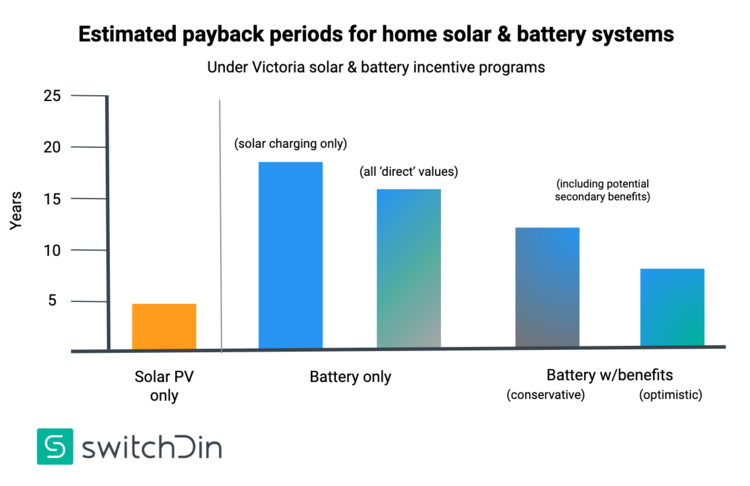Victoria’s home battery storage incentive came into effect from 1 July this year; South Australia, New South Wales, Queensland and the Australian Capital Territory have also introduced incentive programs that support home battery storage system uptake. By reducing out-of-pocket battery storage system costs, these programs will help to expand the market for home batteries in the states, but will still not make battery storage a ‘no brainer’ investment decision for households if batteries are used only to capture & discharge solar energy.
Enabling households to tap into battery value streams additional to the standard ‘solar self-consumption’ approach will be crucial in driving uptake by making batteries more attractive. These include hard, financial benefits like virtual power plant (VPP) participation revenues (for energy market participation as well as grid services) which help shorten payback periods, as well as non-financial benefits such as improved energy self-reliance and blackout protection.
How VPP participation will make a difference
Even though the Victorian incentive or other programs don’t instantly make batteries a mainstream, commonsense investment option like PV already is, they will help to expand the battery storage market by making battery technology more affordable and accessible to a greater number of the households who want it.
The non-financial motivators for battery uptake are unlikely to change much, as they are primarily a matter of consumer preference. On the other hand, there is an opportunity for technological innovation & regulatory change to improve the financial benefits for households.
Because batteries (and other controllable resources) can deliver value to both households as well as energy companies who sell and/or transport electricity (i.e. retailers, networks & integrated utilities), the challenge is not just about making batteries cheaper, but also about developing programs that tap into and share the benefits more effectively.
This arrangement between the customer and energy company usually takes the form of a virtual power plant (VPP) program. Herein lies an opportunity to accelerate the rate of battery uptake in Australia in a way that works in tandem with the gradual decrease in battery system pricing.
Breaking down the value streams
Battery system value types can be divided into two main categories: A) Direct value to the battery system owner (e.g. storing solar energy), and B) Compensation to the homeowner for provision of services under arrangements with utilities, VPP operators and aggregators.
Direct values
 Savings from solar charging: At the moment, for a typical Victorian home the baseline savings attributable directly to a 10kWh battery storage system used only for solar charging are about $300 per year, according to Solar Choice’s Battery Payback Estimator.
Savings from solar charging: At the moment, for a typical Victorian home the baseline savings attributable directly to a 10kWh battery storage system used only for solar charging are about $300 per year, according to Solar Choice’s Battery Payback Estimator.
(Assuming 6kW solar system facing north-east at 30-degree pitch, $0.26/kWh peak and $0.15/kWh off-peak time of use rates, $0.12/kWh feed-in tariff rate, and 20kWh daily energy consumption on ‘evening peak’ usage pattern.)
 Tariff arbitrage: A smart management system capable of pre-charging batteries based on anticipated weather and load requirements should be able to save a home on time-of-use billing at between $25 and $50 per year, according to indicative figures from Solar Choice’s tool under the same assumptions as above. This could be greater or less depending on a number of factors such as the peak/off-peak cost differential and battery size.
Tariff arbitrage: A smart management system capable of pre-charging batteries based on anticipated weather and load requirements should be able to save a home on time-of-use billing at between $25 and $50 per year, according to indicative figures from Solar Choice’s tool under the same assumptions as above. This could be greater or less depending on a number of factors such as the peak/off-peak cost differential and battery size.
 Blackout protection: While other battery ‘soft benefits’ are difficult to put a number to, it may be possible to ascribe a dollar value to blackout protection functionality as ‘blackout insurance’. While the exact value will depend on the home, we’ve assumed here that they would generally be willing to pay between $20-$50/year for for this function. (We note that blackout protection may come with additional equipment costs with some systems.)
Blackout protection: While other battery ‘soft benefits’ are difficult to put a number to, it may be possible to ascribe a dollar value to blackout protection functionality as ‘blackout insurance’. While the exact value will depend on the home, we’ve assumed here that they would generally be willing to pay between $20-$50/year for for this function. (We note that blackout protection may come with additional equipment costs with some systems.)
Compensation for providing services (virtual power plants)
Wholesale energy, RERT, FCAS & network services: Using distributed resources to realise these value streams and then sharing the benefits with households requires both a) smart, secure energy management technology, and b) the involvement of utility, VPP operator and/or aggregator. SwitchDin is working with retailers, integrated utilities & network operators around Australia to unlock these values through our technology.
These values can be tricky to pin down, owing to wholesale price & demand fluctuations themselves, as well as the differences in agreements between VPP operators and participants. Furthermore, it’s also important to consider that benefitting from some of these streams may require the diminution of others (e.g. a battery’s capacity being ‘held’ in anticipation of a spot price spike later in the day). How the benefits are shared will depend on contract terms, which may stipulate how often and to what degree a VPP operator may dispatch participating resources.
In 2018, Victoria experienced six instances of the spot market price exceeding $5/kWh ($5,000/MWh) and about forty below that but still greater than $0.30/kWh. If a household managed to respond to each of these events with 2kWh of energy discharge from their battery and received half the spot price value, they would earn $30 for the year. Assuming 75% value pass through and 3kWh response, this could earn the home about $50 annually.
In an alternative arrangement, a VPP operator could simply pay a flat annual fee to participants for the right to dispatch participant-owned batteries for a limited number of times per year; in this case the end user’s assets may not ever actually be deployed, but instead kept on reserve as a ‘hedge’/insurance for the operator.
Additionally, homes and businesses with access to the spot market’s fluctuating electricity prices may find further opportunities to take advantage of spikes and troughs through strategic battery export and tariff arbitrage.
Frequency control ancillary services (FCAS) plays a key role in maintaining energy system stability. There are several different categories of FCAS on the National Electricity Market and prices can vary for each. There are no direct ways for Victorian battery system owners to participate in (or be rewarded for participating in) the FCAS market, but VPP operators may dispatch batteries for FCAS as part of a VPP bundle, and transfer a portion of value to the battery owners.
While a spate of ‘extreme’ FCAS price events (>$5,000/MW) were an issue in South Australia in 2016/2017, FCAS is a commodity service and does not ordinarily command a high price point. The markets for FCAS are not driven by growth in electricity demand, but rather fluctuations in frequency occurring when generation or loads increase or decrease; this means there may be relatively limited opportunity for FCAS providers to cash in on high prices in the long-term. That being said, the grid’s gradual shift away from synchronous generators and towards intermittent and non-synchronous and variable renewables could result in a greater need for FCAS service providers in the near term – especially in light of the anticipated need for even faster FCAS response (which may be supplied by batteries) during of ‘contingency’ events (e.g. a large generator or load being tripped).
It’s worth noting that FCAS services can be provided from anywhere on the NEM, but at the time that the SA price spikes mentioned above occurred the state was ‘islanded’ from Victoria (and the rest of the NEM) and FCAS had to be delivered locally. This was the main reason for these events. If designed to do so, state-based VPPs may be called into action for FCAS in similar circumstances in the future, fetching a premium in doing so. However, such events will be rare.
The value of FCAS from DERs is difficult to put a number to without complex modelling; furthermore, a small number of new entrant ‘big batteries’ into the FCAS market could absorb a large portion of FCAS opportunities going forward. For the time being, we will assume that Victorian battery systems may benefit between $1.00/kWh and $2.00/kWh five to ten times per year at a rate of 1kWh per event, with total annual benefits ranging from $5 to $20. (We will investigate this topic in more detail in a future article.)
 Reliability and Emergency Reserve Trader (RERT):
Reliability and Emergency Reserve Trader (RERT):
The RERT is a mechanism external to NEM spot markets that AEMO can call on to provide emergency response in advance of significant anticipated imbalances in electricity supply and demand. RERT participants are contracted annually to be on standby for extreme system events; they may be both energy consumers (especially energy-intensive industry) as well as energy producers (which can include aggregations of small-scale battery storage systems).
While the RERT is not dispatched often, when it is the value of services provided can be very high. For example:
On 19 January [2019], this activation cost was some $24 million, almost entirely recovered from Victorian customers. This was for six hours of provision during which a total of 390MWh was dispatched: an average cost of $62,000 per MWh [$62/kWh], roughly twice the average economic cost of involuntary customer interruption without notice – and over four times the Market Price Cap.
Because the potential value of a RERT dispatch is high but the probability of dispatch low, systems aggregators may decide to assume the risk, entering into supply agreement contracts with resource owners (e.g. households with batteries) in exchange for a flat annual access fee. However, aggregators may also contract to pass that value through to participating households on an event-by-event basis. A scan of offers on market in Victoria indicate that a retailer/aggregator may be willing to pay a premium in the region of $50-$100 per year for this ‘insurance’ – but in the event of even just a single RERT dispatch, the earnings could easily exceed this amount by an order of magnitude or greater.
There is substantial opportunity for distributed energy resources to support the stability of local distribution grids, but at present there is no standard marketplace for these services. Instead, distribution network operators may offer their own programs (currently mostly pilots) that incentivise battery uptake (e.g. generous up-front subsidies designed to guarantee buy-in); these factors make it is difficult to determine their ‘market value’.
A comparable program model, Queensland’s PeakSmart incentive for air conditioners (available on the Ergon & Energex networks), offers a one-off rebate of $200 or $400 for households who purchase a demand response-enabled unit (roughly $20-$40/year assuming a 10 year AC unit lifespan). However, batteries are more versatile than AC units in the services they can provide to the grid and could attract higher incentives – possibly ongoing ones. We will therefore estimate a value of $30-$70/year under a ‘PeakSmart for batteries’ style program, were one to be introduced.
 Ongoing subsidies for VPP participation:
Ongoing subsidies for VPP participation:
In the short to medium-term, ongoing VPP participation subsidies may be available as credits for households separate from the other government incentives or the market-based values detailed above. This would constitute an even greater financial advantage for households contributing their batteries and other resources towards a VPP, while giving VPP operators more financial leverage to keep participants happy and engaged.
Currently, this subsidy approach is not commonplace, although the ARENA-backed Virtual Power Plant in South Australia (for which SwitchDin supports several battery products) is a good example of how this type of program might be implemented, giving participants ongoing daily credits for making their batteries available. The credits in this program bundle both the ‘natural’ values outlined above as well as an additional subsidy made possible by ARENA’s funding contribution.
A VPP participation subsidy would not need to be exorbitant to make a difference for householders; just $0.13/day (about $50/year) could help to take a year or more off of a battery’s payback period in the right circumstances. Ultimately, however, we’d expect that VPP programs will ‘stand on their own feet’, only passing through the market & service-based benefits outlined above.
 Community energy programs (‘peer-to-peer’):
Community energy programs (‘peer-to-peer’):
Although they are beyond the scope of this article, we’d like to point out that community (or ‘peer-to-peer’) energy sale/trading programs may enable households to receive further benefits by striking mutually beneficial agreements with friends, family, neighbours or on the open market. In these instances, the value provided by batteries will generally be transacted on an embedded network or microgrid ‘behind’ a grid-connected gateway meter, or via blockchain-style third party cryptocurrencies that do not necessarily require a retailer.
The Victorian outlook
Taking all of these potential values into account, we begin to get a better picture of how smart energy management & VPP participation can have a major impact on battery payback periods. While a battery system incentivised under the Victorian scheme will still have a payback period of close to (or more than) 20 years, adding on the additional direct benefits (smart tariff arbitrage and backup power) could reduce that to 15-16 years, in our estimates.
But it’s sharing the value of the battery system with the greater energy system that could see the most profound improvement in battery payback times, at about 12-14 years in a moderate scenario or as little as 8-9 years in an optimistic one.
This is a significant improvement on the current state of affairs in the Australian battery storage market – keeping in mind that some subsidised programs (including several that SwitchDin helps to facilitate) already offer greater total benefits than those outlined above.
Furthermore, as battery storage prices continue to fall, battery payback periods will begin to enter the territory of solar PV system payback periods. This will help to further accelerate the growth of the smart, distributed energy grid.
More groundwork required
The purpose of this investigation is to scope the full potential value of battery storage to battery storage to households by examining the value of battery services to energy companies. That being said, there is still considerable technical and regulatory groundwork to be laid for the full suite of these values to be realised.
More grid-connect batteries in Victoria and other states will mean a greater number of potential participants in VPP programs (provided those systems are VPP-ready as we’ve suggested they should be). This will help to foster battery uptake and build scale, which will be crucial for the advancement of VPP technology.
The Victorian government will initially be adopting the same ‘approved products’ list as South Australia’s scheme, although they may branch out with their own requirements further down the track. The NSW government has proposed a similar approach for its Empowering Homes program.
Although it is still early days, these moves are suggestive of the future direction of battery storage and virtual power plants in Australia.
A version of this article was originally published on the SwitchDin website.
- Solar Power Wagga Wagga, NSW – Compare outputs, returns and installers - 13 March, 2025
- Monocrystalline vs Polycrystalline Solar Panels: Busting Myths - 11 November, 2024
- Solar Hot Water System: Everything You Need to Know - 27 February, 2024




Very nice article. Promoting renewal sources of energy.